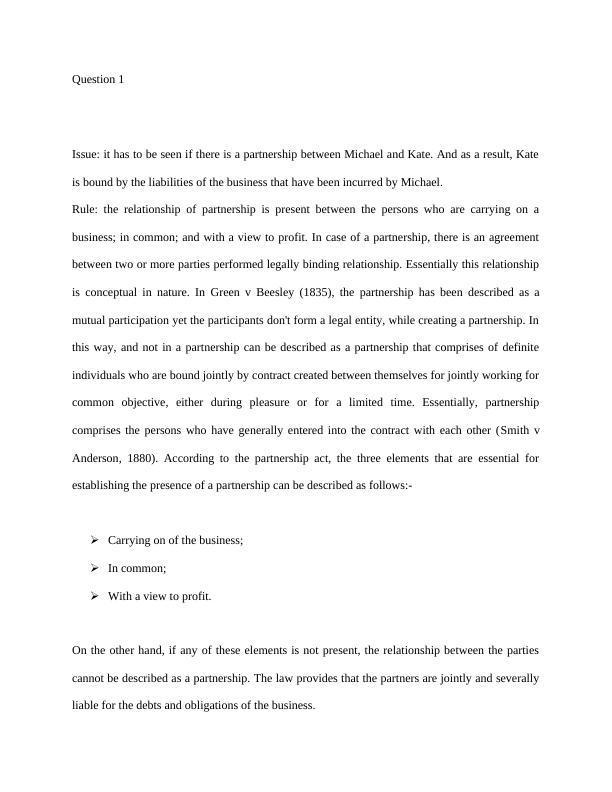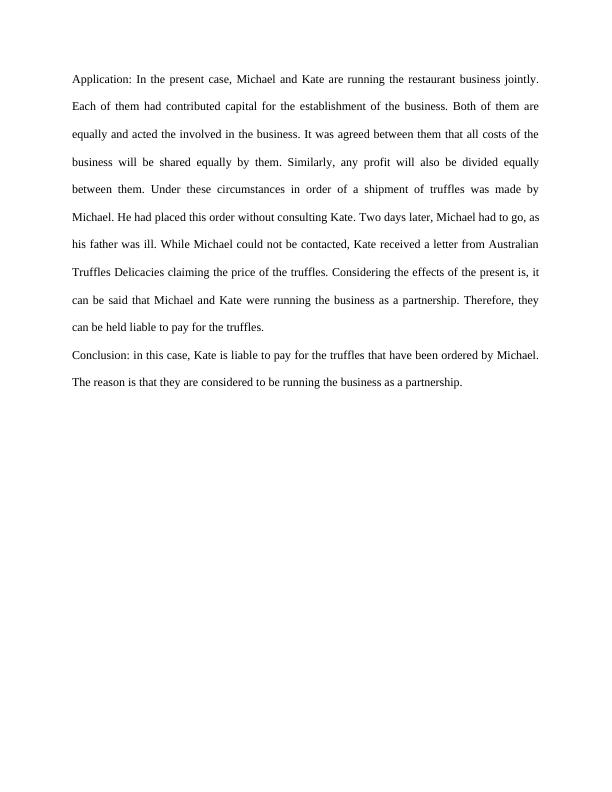Understanding Partnership Law and Contractual Terms in Breach of Contract Cases
Added on 2023-06-03
7 Pages1387 Words472 Views
Question 1
Issue: it has to be seen if there is a partnership between Michael and Kate. And as a result, Kate
is bound by the liabilities of the business that have been incurred by Michael.
Rule: the relationship of partnership is present between the persons who are carrying on a
business; in common; and with a view to profit. In case of a partnership, there is an agreement
between two or more parties performed legally binding relationship. Essentially this relationship
is conceptual in nature. In Green v Beesley (1835), the partnership has been described as a
mutual participation yet the participants don't form a legal entity, while creating a partnership. In
this way, and not in a partnership can be described as a partnership that comprises of definite
individuals who are bound jointly by contract created between themselves for jointly working for
common objective, either during pleasure or for a limited time. Essentially, partnership
comprises the persons who have generally entered into the contract with each other (Smith v
Anderson, 1880). According to the partnership act, the three elements that are essential for
establishing the presence of a partnership can be described as follows:-
Carrying on of the business;
In common;
With a view to profit.
On the other hand, if any of these elements is not present, the relationship between the parties
cannot be described as a partnership. The law provides that the partners are jointly and severally
liable for the debts and obligations of the business.
Issue: it has to be seen if there is a partnership between Michael and Kate. And as a result, Kate
is bound by the liabilities of the business that have been incurred by Michael.
Rule: the relationship of partnership is present between the persons who are carrying on a
business; in common; and with a view to profit. In case of a partnership, there is an agreement
between two or more parties performed legally binding relationship. Essentially this relationship
is conceptual in nature. In Green v Beesley (1835), the partnership has been described as a
mutual participation yet the participants don't form a legal entity, while creating a partnership. In
this way, and not in a partnership can be described as a partnership that comprises of definite
individuals who are bound jointly by contract created between themselves for jointly working for
common objective, either during pleasure or for a limited time. Essentially, partnership
comprises the persons who have generally entered into the contract with each other (Smith v
Anderson, 1880). According to the partnership act, the three elements that are essential for
establishing the presence of a partnership can be described as follows:-
Carrying on of the business;
In common;
With a view to profit.
On the other hand, if any of these elements is not present, the relationship between the parties
cannot be described as a partnership. The law provides that the partners are jointly and severally
liable for the debts and obligations of the business.

Application: In the present case, Michael and Kate are running the restaurant business jointly.
Each of them had contributed capital for the establishment of the business. Both of them are
equally and acted the involved in the business. It was agreed between them that all costs of the
business will be shared equally by them. Similarly, any profit will also be divided equally
between them. Under these circumstances in order of a shipment of truffles was made by
Michael. He had placed this order without consulting Kate. Two days later, Michael had to go, as
his father was ill. While Michael could not be contacted, Kate received a letter from Australian
Truffles Delicacies claiming the price of the truffles. Considering the effects of the present is, it
can be said that Michael and Kate were running the business as a partnership. Therefore, they
can be held liable to pay for the truffles.
Conclusion: in this case, Kate is liable to pay for the truffles that have been ordered by Michael.
The reason is that they are considered to be running the business as a partnership.
Each of them had contributed capital for the establishment of the business. Both of them are
equally and acted the involved in the business. It was agreed between them that all costs of the
business will be shared equally by them. Similarly, any profit will also be divided equally
between them. Under these circumstances in order of a shipment of truffles was made by
Michael. He had placed this order without consulting Kate. Two days later, Michael had to go, as
his father was ill. While Michael could not be contacted, Kate received a letter from Australian
Truffles Delicacies claiming the price of the truffles. Considering the effects of the present is, it
can be said that Michael and Kate were running the business as a partnership. Therefore, they
can be held liable to pay for the truffles.
Conclusion: in this case, Kate is liable to pay for the truffles that have been ordered by Michael.
The reason is that they are considered to be running the business as a partnership.

Question 2
Issue: The issue here is related with the terms and conditions of the contract created between
Damion and Cassandra.
Rule: Every contract has key terms. These terms fall into different categories. The parties made
expressly agree regarding the terms of the contract, orally or in writing. At the same time, terms
may also be implied by the law in a contract or from the conduct of the parties, custom, previous
dealing or the intention of the parties.
In this context, the terms of a contract can be described as conditions, warranties and innominate
terms. This can be specified by the parties and the contract or implied by the nature of the or
implied by law.
A term of the contract can be described as a condition if in case of a breach of the term, the other
party gets the right to either terminate the contract or performing. At the same time, in such a
case, the aggrieved party also has the right to claim damages.
On the other hand, in case of a breach of warranty, the other party does not get the right to
terminate the contract. Therefore in case of a breach of warranty, the aggrieved party only gets
the right to claim damages. In this way, a term can be described as a condition if it is a basic term
of the contract and goes to the root of the contract. Conversely, a statement or an assurance made
regarding a factual matter will generally be considered as a warranty. The difference between the
two can be explained with the help of famous cases of Poussard v Spiers (1875) and Bettini v
Gye (1875).
In case of innominate terms, the remedy for the breach of contract depends on the effect of the
breach. Therefore, if the breach has substantial effect on the eve party, it will be considered as a
Issue: The issue here is related with the terms and conditions of the contract created between
Damion and Cassandra.
Rule: Every contract has key terms. These terms fall into different categories. The parties made
expressly agree regarding the terms of the contract, orally or in writing. At the same time, terms
may also be implied by the law in a contract or from the conduct of the parties, custom, previous
dealing or the intention of the parties.
In this context, the terms of a contract can be described as conditions, warranties and innominate
terms. This can be specified by the parties and the contract or implied by the nature of the or
implied by law.
A term of the contract can be described as a condition if in case of a breach of the term, the other
party gets the right to either terminate the contract or performing. At the same time, in such a
case, the aggrieved party also has the right to claim damages.
On the other hand, in case of a breach of warranty, the other party does not get the right to
terminate the contract. Therefore in case of a breach of warranty, the aggrieved party only gets
the right to claim damages. In this way, a term can be described as a condition if it is a basic term
of the contract and goes to the root of the contract. Conversely, a statement or an assurance made
regarding a factual matter will generally be considered as a warranty. The difference between the
two can be explained with the help of famous cases of Poussard v Spiers (1875) and Bettini v
Gye (1875).
In case of innominate terms, the remedy for the breach of contract depends on the effect of the
breach. Therefore, if the breach has substantial effect on the eve party, it will be considered as a

End of preview
Want to access all the pages? Upload your documents or become a member.
Related Documents
Partnership Law and Liability for Negligent Misrepresentationlg...
|10
|3191
|155
Partnership in Business Case Studylg...
|7
|2340
|190
Business and Corporation Lawlg...
|10
|2074
|456
Application of Contract Law Principles in Three Scenarioslg...
|8
|2206
|500
MA506/GA506 Business and Company Lawlg...
|7
|2364
|263
Business Lawlg...
|10
|2358
|160
